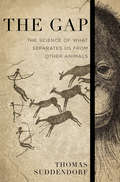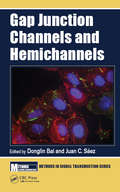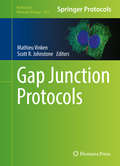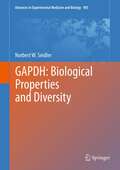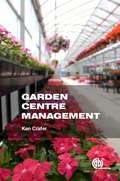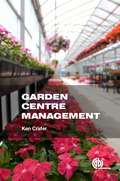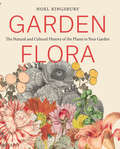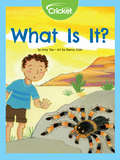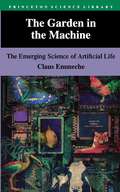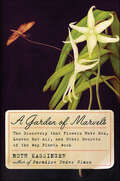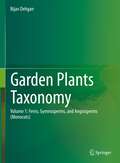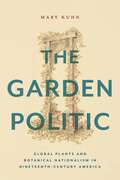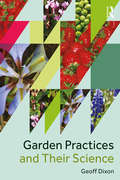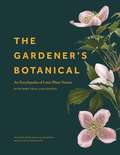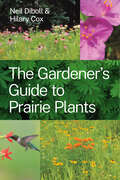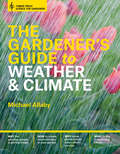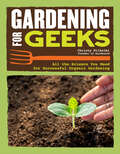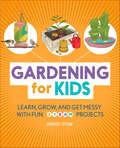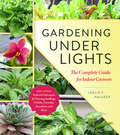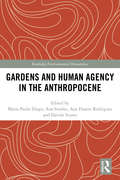- Table View
- List View
Ganzkörper-Elektromyostimulation: Effekte, Limitationen, Perspektiven einer innovativen Trainingsmethode (essentials)
by Wolfgang Kemmler Michael Fröhlich Christoph EiflerDas vorliegende Essential versteht sich als kompaktes Nachschlagewerk für Fragen und Aspekte rund um die innovative Trainingstechnologie Ganzkörper-Elektromyostimulation (WB-EMS). Neben Hintergründen und Informationen zur WB-EMS Applikation, bei der die Autoren besonderes Augenmerk auf die sichere und effektive Anwendung legen, erfolgt eine aktuelle Übersicht über Forschungsergebnisse, welche die Effekte von WB-EMS auf unterschiedliche Zielgrößen zusammenfasst. Abschließend wird eine Charakterisierung der Marksituation sowie derzeitiger Trends und eine Prognose von Entwicklungen im Spannungsfeld WB-EMS vorgelegt.
The Gap: The Science of What Separates Us from Other Animals
by Thomas SuddendorfThere exists an undeniable chasm between the capacities of humans and those of animals, but what exactly is the difference between our minds and theirs? In "The Gap," psychologist Thomas Suddendorf provides a definitive account of what makes human minds unique and how this disparity arose. He proposes that two innovations account for all of the ways in which our minds appear so distinct: our open-ended ability to imagine and reflect, and our insatiable drive to link our minds together. It is not language or morality that set us apart, but the ability to consider a range of scenarios, real and imagined, past and future. A provocative argument for reconsidering our place in nature, "The Gap" is essential reading for anyone interested in our evolutionary origins and our relationship with the rest of the animal kingdom.
Gap Junction Channels and Hemichannels (Methods in Signal Transduction Series)
by Donglin Bai Juan C. SáezGap junction channels are a group of intercellular channels expressed in tissues and organs to synchronize many physiological processes. A gap junction channel is formed by the docking of two hemichannels, and each hemichannel is a hexamer of connexins. The field of gap junction channel and hemichannel research has recently exploded and became one of the most active areas of cell biology. Numerous novel approaches and techniques have been developed, but there is no single book dedicated to the unique techniques and protocols employed for the research on these large pore channels. This book fills the gap and focuses on protocols, approaches and reviews of gap junction channels and connexin hemichannels. It will be a useful reference for graduate students, postdoctoral fellows and researchers. Anyone with an interest in gap junction channels and hemichannels will need this summary of state-of-the-art techniques and protocols.
Gap Junction Protocols
by Mathieu Vinken Scott R. JohnstonePresenting state-of-the-art protocols to study gap junctions, this detailed book first focuses on the use of methods and tools to investigate the different aspects of connexin expression and gap junction regulation. The second part of the volume describes several methods to probe gap junction functionality as such. Written in the highly successful Methods in Molecular Biology series format, chapters include introductions to their respective topics, lists of the necessary materials and reagents, step-by-step and readily reproducible laboratory protocols, and key tips on troubleshooting and avoiding known pitfalls. Authoritative and practical, Gap Junction Protocols is intended for basic and applied researchers in the area of biomedical and life sciences, both in academic and industrial settings.
GAPDH: Biological Properties and Diversity
by Norbert W. SeidlerThe book represents a comprehensive review and synthesis of the biomedical literature that spans over a half-century on a single protein called glyceraldehyde 3-phosphate dehydrogenase (or, GAPDH). Due to the protein's involvement in a vast array of cellular activities, GAPDH is of interest to the cell biologist, immunologist, virologist, biochemist etc. The protein has a significant role in fertility, cancer and neurodegeneration, suggesting that this book can be a vital resource for drug development. GAPDH function may provide insight into anesthesia. Furthermore, GAPDH is highly conserved meaning that the protein found in microorganisms, such as pathogens, remained relatively unchanged in evolution. Pathogens use GAPDH as a virulence factor, offering a unique challenge in developing anti-microbial agents that target this protein. To the evolutionary biologist, a book on the multi-functionality of GAPDH provides a focal point for a cogent discussion on the very origin of life.
The Garbage Crawler, The Prophetess of York, A Pitman in Atlantis
by John CritchleyThe Garbage Crawler, The Prophetess of York, A Pitman in Atlantis are an enthralling trio of plays set for the radio and the stage, concerning myth, legend and science fiction. In The Garbage Crawler, we find Zachery, who has only ever known his room and the robotic voice that controls his life. He escapes into a sea of rat-infested, foul-smelling garbage through a chute, where he is discovered by a Finder. His destiny and that of the city he comes to come into question as he becomes a Finder himself and looks to liberate the city. Set in York in 1833, The Prophetess of York is 19-year-old Hannah Beedham, a self-professed 'common sinner'. She experiences a glorious vision of God himself, but the people of York denounce her as a drunk and a witch. However, local man James Sturdy believes her, as do some from all over who pay tribute to the 'Prophetess'. A Pitman in Atlantis sees John Bell fall from a sea defence wall in Yorkshire and wake up in a foreign hospital, only to find he has landed in Atlantis. He begins working in a silver mine in the underwater city while fellow Englishmen work to try and find a way for John to return to his wife and the world on the surface.
The Garden (Early Reader Non Fiction)
by Louisa LeamanEarly Readers are stepping stones from picture books to reading books. A green Early Reader is a first factbook.It's never too early to find out about... The Garden.Bugs and beetles, birds and plants, there's a world to be discovered and it's right on your doorstep. Beautifully illustrated in full colour on every page, this new Early Reader will show you the amazing possibilities of the great outdoors!
Garden Centre Management
by Ken CraferGarden Centre management has professionalised in recent years as garden centres have become more highly developed retail operations. Many students of horticulture are expected to go into retail management and so the topic has increasingly appeared on the further education curriculum. This book is equally targeted at students, garden centre managers and professional courses in garden centre management. It provides a practical approach backed up by management theory. The text covers consumer behaviour, staff management, stock management, marketing and productivity.
Garden Centre Management
by Ken CraferGarden Centre management has professionalised in recent years as garden centres have become more highly developed retail operations. Many students of horticulture are expected to go into retail management and so the topic has increasingly appeared on the further education curriculum. This book is equally targeted at students, garden centre managers and professional courses in garden centre management. It provides a practical approach backed up by management theory. The text covers consumer behaviour, staff management, stock management, marketing and productivity.
Garden Flora: The Natural and Cultural History of the Plants In Your Garden
by Noel Kingsbury“A beautifully illustrated reference book covers the origins, ecology and history of popular garden plants.” —Shelf Awareness The oldest rose fossil was found in Colorado and dates to 35 million years ago. Marigolds, infamous for their ability to self-seed, are named for an Etruscan god who sprang from a ploughed field. And daffodils—an icon of spring—were introduced to Britain by the Romans more than 2,000 years ago. Every garden plant has an origination story, and Garden Flora, by noted garden designer Noel Kingsbury, shares them in a beautifully compelling way. This lushly illustrated survey of 133 of the most commonly grown plants explains where each plant came from and the journey it took into home gardens. Kingsbury tells intriguing tales of the most important plant hunters, breeders, and gardeners throughout history, and explores the unexpected ways plants have been used. Richly illustrated with an eclectic mix of new and historical photos, botanical art, and vintage seed packets and catalogs, Garden Flora is a must-have reference for every gardener and plant lover.
Garden Guesthouse: Is It What Jesus Intended?
by Nancy Cote Amy TaoHave you ever heard of a bug hotel? There are some insects that help plants by spreading pollen and improving the soil, but they don’t always show up in every garden. To help encourage them to move in, some gardeners build little houses for them!
The Garden in the Machine: The Emerging Science of Artificial Life (Princeton Science Library #121)
by Claus EmmecheWhat is life? Is it just the biologically familiar--birds, trees, snails, people--or is it an infinitely complex set of patterns that a computer could simulate? What role does intelligence play in separating the organic from the inorganic, the living from the inert? Does life evolve along a predestined path, or does it suddenly emerge from what appeared lifeless and programmatic? In this easily accessible and wide-ranging survey, Claus Emmeche outlines many of the challenges and controversies involved in the dynamic and curious science of artificial life. Emmeche describes the work being done by an international network of biologists, computer scientists, and physicists who are using computers to study life as it could be, or as it might evolve under conditions different from those on earth. Many artificial-life researchers believe that they can create new life in the computer by simulating the processes observed in traditional, biological life-forms. The flight of a flock of birds, for example, can be reproduced faithfully and in all its complexity by a relatively simple computer program that is designed to generate electronic "boids." Are these "boids" then alive? The central problem, Emmeche notes, lies in defining the salient differences between biological life and computer simulations of its processes. And yet, if we can breathe life into a computer, what might this mean for our other assumptions about what it means to be alive? The Garden in the Machine touches on every aspect of this complex and rapidly developing discipline, including its connections to artificial intelligence, chaos theory, computational theory, and studies of emergence. Drawing on the most current work in the field, this book is a major overview of artificial life. Professionals and nonscientists alike will find it an invaluable guide to concepts and technologies that may forever change our definition of life.
A Garden of Marvels: How We Discovered that Flowers Have Sex, Leaves Eat Air, and Other Secrets of Plants
by Ruth KassingerIn the tradition of The Botany of Desire and Wicked Plants, a witty and engaging history of the first botanists interwoven with stories of today’s extraordinary plants found in the garden and the lab.In Paradise Under Glass, Ruth Kassinger recounted with grace and humor her journey from brown thumb to green, sharing lessons she learned from building a home conservatory in the wake of a devastating personal crisis.In A Garden of Marvels, she extends the story. Frustrated by plants that fail to thrive, she sets out to understand the basics of botany in order to become a better gardener. She retraces the progress of the first botanists who banished myths and misunderstandings and discovered that flowers have sex, leaves eat air, roots choose their food, and hormones make morning glories climb fence posts. She also visits modern gardens, farms, and labs to discover the science behind extraordinary plants like one-ton pumpkins, a truly black petunia, a biofuel grass that grows twelve feet tall, and the world's only photosynthesizing animal. Transferring her insights to her own garden, she nurtures a "cocktail" tree that bears five kinds of fruit, cures a Buddha's Hand plant with beneficial fungi, and gets a tree to text her when it's thirsty.Intertwining personal anecdote, accessible science, and untold history, the ever-engaging author takes us on an eye-opening journey into her garden—and yours.
Garden Plants Taxonomy: Volume 1: Ferns, Gymnosperms, and Angiosperms (Monocots)
by Bijan DehganHorticulture has remained far behind in understanding of botanical principles. Recent phylogenetic (DNA-based) reorganization of higher plants has revolutionized taxonomic treatments of all biological entities, even when morphology does not completely agree with their organization. This book is an example of applying principals of botanical phylogenetic taxonomy to assemble genera, species, and cultivars of 200 vascular plant families of ferns, gymnosperms, and angiosperms that are cultivated for enhancement of human living space; homes, gardens, and parks. The emphases are on cultivated species but examples of some plants are often shown in the wild and in landscapes. In providing descriptions, it is assumed that students and other interested individuals have no background in general botany (plant characteristics), or nomenclature. Fundamental features of all plant groups discussed are fully illustrated by original watercolor drawings or photographs. Discussion of the families is grounded on recent botanical phylogenetic treatments, which is based on common ancestry (monophyly). Of course, phylogenetic taxonomy is not a new concept, and was originally based on morphological characteristics; it is the DNA-based phylogeny that has revolutionized modern biological classifications. In practical terms, this book represents the horticultural treatment that corresponds to phylogenetic-based botanical taxonomy, to which is added cultigens and cultivated genera and species. Hence, the harmony between horticultural and botanical taxonomy. This book covers phylogenetic-based taxonomy of Ferns, Gymnosperms, and Angiosperms (Monocots). A companion volume covers Angiosperms (Eudicots).
The Garden Politic: Global Plants and Botanical Nationalism in Nineteenth-Century America (America and the Long 19th Century #27)
by Mary KuhnHow worldwide plant circulation and new botanical ideas enabled Americans to radically re-envision politics and societyThe Garden Politic argues that botanical practices and discourses helped nineteenth-century Americans engage pressing questions of race, gender, settler colonialism, and liberal subjectivity. In the early republic, ideas of biotic distinctiveness helped fuel narratives of American exceptionalism. By the nineteenth century, however, these ideas and narratives were unsettled by the unprecedented scale at which the United States and European empires prospected for valuable plants and exchanged them across the globe. Drawing on ecocriticism, New Materialism, environmental history, and the history of science—and crossing disciplinary and national boundaries—The Garden Politic shows how new ideas about cultivation and plant life could be mobilized to divergent political and social ends. Reading the work of influential nineteenth-century authors from a botanical perspective, Mary Kuhn recovers how domestic political issues were entangled with the global circulation and science of plants. The diversity of Harriet Beecher Stowe’s own gardens contributed to the evolution of her racial politics and abolitionist strategies. Nathaniel Hawthorne’s struggles in his garden inspired him to write stories in which plants defy human efforts to impose order. Radical scientific ideas about plant intelligence and sociality prompted Emily Dickinson to imagine a human polity that embraces kinship with the natural world. Yet other writers, including Frederick Douglass, cautioned that the most prominent political context for plants remained plantation slavery. The Garden Politic reveals how the nineteenth century’s extractive political economy of plants contains both the roots of our contemporary environmental crisis and the seeds of alternative political visions.
Garden Ponds
by Dennis Kelsey-Wood Tom BarthelIn this colorful Garden Ponds Made Easy title, authors Dennis Kelsey-Wood and Tom Barthell have provided an essential guide for first-time pond enthusiasts. The authors outline all of the considerations for starting out with a new pond, including determining the site, style, size of the pond, and deciding on the construction of the pond (whether preformed, concrete, or fiberglass). Garden Ponds offers a chapter on water which discusses water chemistry factors, volume of the pond, and pond surface. Other important factors involve the aeration, filtration, drainage, and maintenance of a clean (algae-free) pond. Special features, including waterfalls, fountains, and watercourses, electricity, and landscaping are addressed in detail, all accompanied by color photographs and drawings. A chapter on pond construction details every step of the project from creating a blueprint to securing the foundation. The infinite choices involved with stocking the pond with fish and plants can be overwhelming for the first-time pond owner, and the authors give excellent advice about making smart choices for a harmonious, beautiful garden pond. A special chapter on seasonal pond care gives the pond keeper recommendations for maintaining the pond all year long. Resources and glossary included.
Garden Practices and Their Science
by Geoff DixonWritten in a clear and accessible style, Garden Practices and Their Science guides gardeners in the practical arts of plant husbandry and in their understanding of its underpinning principles. The author, Professor Geoff Dixon, is an acknowledged and internationally respected horticulturist and microbiologist; he intertwines these arts and principles carefully, expertly leading readers from one to the other. Achieving the manipulation of plant life is described in eight full-colour, well-illustrated chapters covering the growing of potatoes, bulb onions, legumes, small-seeded vegetables, soft fruit, bulbs and herbaceous ornamentals in great detail. Environmental factors controlling the successful husbandry of these crops is described in simple, non-technical language, increasing gardeners’ enjoyment and competence. Gardeners are also informed of the tools and equipment they require and their safe use. Also provided are a series of simple, straightforward tests identifying the aerial and soil environments beneficial for plant growth using readily accessible domestic tools. Discussions of very straightforward techniques for vegetative propagation conclude this book. Each chapter ends with a list of the gardening knowledge that has been gained by readers. The structure of this book fulfils a longstanding need for descriptions of practical skills integrated with the corresponding biological reactions of plants. Emphasis is placed on gardeners’ development of healthy soils, which encourage vigorous, active root systems capable of withstanding stresses—an aspect of gardening that rarely receives sufficient attention. Tailored for readers requiring clear and concise directions, this very practical book is an instruction manual directed at early-stage gardening learners. These include people of all ages and requirements such as new garden owners, allotment-holders, apprentices and students of basic levels in the Royal Horticultural Society’s or City & Guilds qualifications, career changers, community gardeners and those needing applied biological knowledge for GCSE examinations.
The Gardener's Botanical: An Encyclopedia of Latin Plant Names - with More than 5,000 Entries
by The Gardener's B Ross BaytonThe definitive guide to botanical Latin. Unlock the secrets of botanical Latin with this beautifully illustrated encyclopedia. The Gardener's Botanical contains definitions of more than 5,000 plant names—from abbreviatus ("shortened") to zonatus ("with bands")—along with more than 350 color illustrations. Scientific plant names are an invaluable tool for those who understand them. Formed from Greek and, more commonly, from Latin root words, not only do they make it possible for gardeners and botanists to communicate, they also contain a wealth of hidden information. The Gardener's Botanical is the key to unlocking these secrets. This guide contains a breathtaking array of botanical names in alphabetical order. Each word is listed with a pronunciation guide, definition, example plant, and, where appropriate, etymology. Also included in this illuminating guide are special features on important plant genera, fact boxes, essays focusing on the history and importance of Latin names and botanical illustrations, and an index of common names with more than 2,000 popular plants, cross-referenced with their binomial name in Latin.
The Gardener's Guide to Prairie Plants (Emersion: Emergent Village Resources For Communities Of Faith Ser.)
by Neil Diboll Hilary CoxA comprehensive and beautifully illustrated reference for all gardeners passionate about native plants and prairie restoration. The Gardener’s Guide to Prairie Plants is the one-stop compendium for all gardeners aspiring to use native prairie plants in their gardens. Neil Diboll and Hilary Cox—two renowned prairie gardeners—compile more than four decades’ worth of research to offer a wide-ranging and definitive reference for starting and maintaining prairie and meadow gardens and restorations. Alongside detailed synopses of plant life cycles, meticulous range maps, and sweeping overviews of natural history, Diboll and Cox also include photographs of 148 prairie plants in every stage of development, from seedling to seedhead. North America’s grasslands once stretched from the Blue Ridge to the Rocky Mountains, and from Texas to Manitoba, blanketing the mid-continent with ecologically important, garden-worthy, native species. This book provides all the inspiration and information necessary for eager native planters from across the country to welcome these plants back to their landscapes. The Gardener’s Guide to Prairie Plants is a must-have reference for gardeners, restorationists, and every flora fan with a passion for native plants, prairies and meadows.
The Gardener's Guide to Prairie Plants (Emersion: Emergent Village Resources For Communities Of Faith Ser.)
by Neil Diboll Hilary CoxA comprehensive and beautifully illustrated reference for all gardeners passionate about native plants and prairie restoration. The Gardener’s Guide to Prairie Plants is the one-stop compendium for all gardeners aspiring to use native prairie plants in their gardens. Neil Diboll and Hilary Cox—two renowned prairie gardeners—compile more than four decades’ worth of research to offer a wide-ranging and definitive reference for starting and maintaining prairie and meadow gardens and restorations. Alongside detailed synopses of plant life cycles, meticulous range maps, and sweeping overviews of natural history, Diboll and Cox also include photographs of 148 prairie plants in every stage of development, from seedling to seedhead. North America’s grasslands once stretched from the Blue Ridge to the Rocky Mountains, and from Texas to Manitoba, blanketing the mid-continent with ecologically important, garden-worthy, native species. This book provides all the inspiration and information necessary for eager native planters from across the country to welcome these plants back to their landscapes. The Gardener’s Guide to Prairie Plants is a must-have reference for gardeners, restorationists, and every flora fan with a passion for native plants, prairies and meadows.
The Gardener's Guide to Weather and Climate: How to Understand the Weather and Make It Work for You (Science For Gardeners Ser.)
by Michael Allaby“We owe it to our plants to read this book. After all, while we just live with the weather, our plants have to survive it.” —The Washington Post All gardeners are at the whim of Mother Nature, and so are our plants. Whether it’s coping with extreme drought or record-breaking snow fall, gardeners—and gardens—across the country are fighting against the elements. Instead of just reacting to the weather, Michael Allaby suggests that gardeners use knowledge about how the weather works to create the best growing conditions for their plants. Allaby brings big-picture atmospheric concepts to life with a comprehensive introduction to how weather works and explanations climate change, weather systems, and microclimates. The Gardener’s Guide to Weather and Climate proves that instead of gardening at the mercy of the weather, knowledgeable gardeners can make the weather work for them
Gardening for Geeks: All the Science You Need for Successful Organic Gardening
by Christy WilhelmiThe founder of Gardenerd.com presents ultimate guide to organic gardening for geeks who want to know the science behind flourishing flora. In Gardening for Geeks, Christy Wilhelmi breaks down the biology and ecology of gardening in an engaging and accessible way. She explains how plants work, how soil lives, how bugs help, and much more. Plus she offers practical advice on everything from planning to pest control. Filled with more than one hundred fifty photos, step-by-step processes, helpful diagrams and illustrations, and expert tips, this beginner's guide covers all the gardening basics, whether you're planting in the country or in an urban area. Christy then introduces more advanced concepts, strategies, and techniques to help you get the most out of your garden. This edition also includes plant profiles, the latest research and terminology, and more photographs and illustrations.
Gardening for Kids: Learn, Grow, and Get Messy with Fun STEAM Projects
by Brandy StoneSharpen STEAM skills—and have a blast—with educational gardening projects for kids 8 to 12Discover how fun and educational growing plants can be. Gardening for Kids is packed with essential information for beginner gardeners and tons of awesome projects that help kids grow their science, technology, engineering, art, and math (STEAM) skills.Go outside with easy-to-try experiments that will teach you all about the environment, plants, and what it takes to grow and maintain your very own garden. Find out what your soil is made of, make a miniature greenhouse, race seeds, and so much more!Gardening for Kids provides:Gardening 101—Learn everything you need to get your garden started today, from basic safety tips to helpful advice on caring for your plants.25 Gardening projects—Dig into the natural world with a ton of fun experiments like sprouting food scraps, building plant forts, and more—each one focusing on specific STEAM skills.A chance to grow together—This book features handy tips for expanding projects to work with groups of kids so you can share the fun in classrooms and community gardens.Grow a love of science, technology, engineering, art, and math—plus lots of plants—with Gardening for Kids.
Gardening Under Lights: The Complete Guide for Indoor Growers
by Leslie F. Halleck“If you want to grow plants indoors, you need this book.” —Niki Jabbour, author and staff writer at savvygardening.comGardening Under Lights is a highly-detailed, accessible guide for seed starters, plant collectors, houseplant fans, and anyone who wants to successfully garden indoors any time of the year. You’ll learn the basics of photosynthesis, the science of light, how to accurately measure how much light a plant needs, and details about the most up-to-date tools and gear available. Also included are tips and techniques for helping ornamental plants (like orchids, succulents, bonsai, and more) and edible plants (arugula, cannabis, oregano, tomatoes, and more) thrive indoors. Whether you are a vegetable gardener who wants to extend the growing season, a balcony gardener short on outdoor space, or a specialty plant collector, Gardening Under Lights is a must-have.
Gardens and Human Agency in the Anthropocene (Routledge Environmental Humanities)
by Maria Paula Diogo Ana Duarte Rodrigues Ana Simões Davide ScarsoThis volume discusses gardens as designed landscapes of mediation between nature and culture, embodying different levels of human control over wilderness, defining specific rules for this confrontation and staging different forms of human dominance. The contributing authors focus on ways of rethinking the garden and its role in contemporary society, using it as a crossover platform between nature, science and technology. Drawing upon their diverse fields of research, including History of Science and Technology, Environmental Studies, Gardens and Landscape Studies, Urban Studies, and Visual and Artistic Studies, the authors unveil various entanglements woven in the past between nature and culture, and probe the potential of alternative epistemologies to escape the predicament of fatalistic dystopias that often revolve around the Anthropocene debate. This book will be of great interest to those studying environmental and landscape history, the history of science and technology, historical geography, and the environmental humanities.

